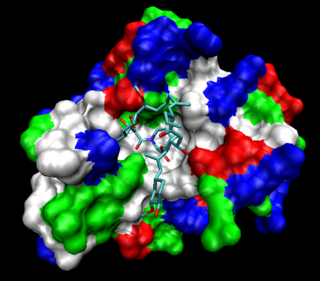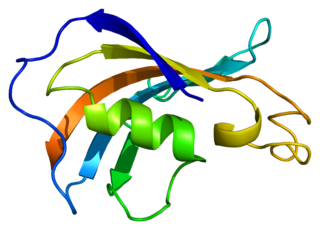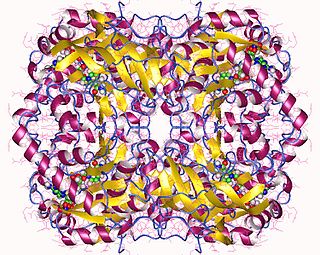
Tacrolimus, sold under the brand name Prograf among others, is an immunosuppressive drug. After allogenic organ transplant, the risk of organ rejection is moderate. To lower the risk of organ rejection, tacrolimus is given. The drug can also be sold as a topical medication in the treatment of T-cell-mediated diseases such as eczema and psoriasis. For example, it is prescribed for severe refractory uveitis after a bone marrow transplant, exacerbations of minimal change disease, Kimura's disease, and vitiligo. It can be used to treat dry eye syndrome in cats and dogs.

Streptomyces is the largest genus of Actinomycetota, and the type genus of the family Streptomycetaceae. Over 700 species of Streptomyces bacteria have been described. As with the other Actinomycetota, streptomycetes are gram-positive, and have very large genomes with high GC content. Found predominantly in soil and decaying vegetation, most streptomycetes produce spores, and are noted for their distinct "earthy" odor that results from production of a volatile metabolite, geosmin. Different strains of the same species may colonize very diverse environments.

Ascomycin, also called Immunomycin, FR-900520, FK520, is an ethyl analog of tacrolimus (FK506) with strong immunosuppressant properties. It has been researched for the treatment of autoimmune diseases and skin diseases, and to prevent rejection after an organ transplant.
Streptomyces clavuligerus is a species of Gram-positive bacterium notable for producing clavulanic acid.

The FKBPs, or FK506 binding proteins, constitute a family of proteins that have prolyl isomerase activity and are related to the cyclophilins in function, though not in amino acid sequence. FKBPs have been identified in many eukaryotes, ranging from yeast to humans, and function as protein folding chaperones for proteins containing proline residues. Along with cyclophilin, FKBPs belong to the immunophilin family.

Peptidyl-prolyl cis-trans isomerase FKBP1A is an enzyme that in humans is encoded by the FKBP1A gene. It is also commonly referred to as FKBP-12 or FKBP12 and is a member of a family of FK506-binding proteins (FKBPs).

FK506 binding protein 5, also known as FKBP5, is a protein which in humans is encoded by the FKBP5 gene.

Peptidyl-prolyl cis-trans isomerase FKBP1B is an enzyme that in humans is encoded by the FKBP1B gene.

FK506-binding protein 3 also known as FKBP25 is a protein that in humans is encoded by the FKBP3 gene.

FK506-binding protein 2 is a protein that in humans is encoded by the FKBP2 gene.

Crotonyl-CoA carboxylase/reductase (EC 1.3.1.85, CCR, crotonyl-CoA reductase (carboxylating)) is an enzyme with systematic name (2S)-ethylmalonyl-CoA:NADP+ oxidoreductase (decarboxylating). This enzyme catalyses the following chemical reaction
Streptomyces isolates have yielded the majority of human, animal, and agricultural antibiotics, as well as a number of fundamental chemotherapy medicines. Streptomyces is the largest antibiotic-producing genus of Actinomycetota, producing chemotherapy, antibacterial, antifungal, antiparasitic drugs, and immunosuppressants. Streptomyces isolates are typically initiated with the aerial hyphal formation from the mycelium.
Streptomyces albidoflavus is a bacterium species from the genus of Streptomyces which has been isolated from soil from Poland. Streptomyces albidoflavus produces dibutyl phthalate and streptothricins.
Streptomyces alboflavus is a bacterium species from the genus of Streptomyces which produces oxytetracycline, tetracycline and desertomycin A.
Streptomyces chattanoogensis is a bacterium species from the genus of Streptomyces which has been isolated from soil in Tennessee in the United States. Streptomyces chattanoogensis produces natamycin.
Streptomyces durmitorensis is a bacterium species from the genus of Streptomyces which has been isolated from soil from the Durmitor National Park in Serbia and Montenegro.
Streptomyces exfoliatus is a bacterium species from the genus of Streptomyces which has been isolated from soil. Streptomyces exfoliatus has the ability to degrade poly(3-hydroxyalkanoate). This species produces exfoliatin and exfoliamycin.
Streptomyces filipinensis is a bacterium species from the genus of Streptomyces which has been isolated from soil on the Philippines. Streptomyces filipinensis produces pentalenolactone I, hygromycin A and filipin.
Streptomyces rapamycinicus is a bacterium species from the genus of Streptomyces which has been isolated from soil from the Easter island. Streptomyces rapamycinicus produces sirolimus.
Streptomyces tacrolimicus is a bacterium species from the genus of Streptomyces which has been isolated from deer dung. Streptomyces tacrolimicus produces tacrolimus.









